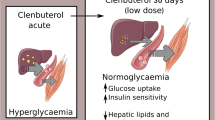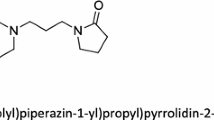Abstract
The effects of α2-adrenoceptor agonists (dexmedetomidine, oxymetazoline), alone or in combination with various α-adrenoceptor subtype-selective antagonists (CH-38083, idazoxan, WB4101, BRL44408, ARC-239, prazosin), on noradrenaline- and isoprenaline-induced lipolysis were investigated in human isolated abdominal subcutaneous fat cells. The rank order of potency of antagonists in preventing dexmedetomidine- and oxymetazoline-evoked suppression of isoprenaline-induced lipolysis was (pA2-values): CH-38083 (7.69 and 7.48) ≅ idazoxan (7.5 and 7.41) > BRL 44408 (7.23 and 7.19) ≅ WB 4101 (7.13 and 7.12) > prazosin (5.18 and 5.17) > ARC-239 (4.72, 4.9). While CH-38083 and idazoxan, non-subtype selective α2-adrenoceptor antagonists and BRL44408, a selective a2A-adrenoceptor antagonist as well as WB4101 potentiated the lipolytic effect of noradrenaline, ARC-239, the selective α2B-adrenoceptor antagonist failed to affect it. In addition since the α2A-adrenoceptor selective agonist, oxymetazoline concentration dependently inhibited the lipolytic effect of isoprenaline, and WB4101 and BRL44408 (a2A-adrenoceptor antagonists) antagonised the effect of oxymetazoline in a competitive manner, it is concluded that the a2A-adrenoceptor subtype is involved in antilipolysis. In addition, functional evidence was obtained that there is an interaction between α2A- and β-adrenoceptors located on the cell surface of adipocytes, through which locally released noradrenaline and/or circulating circulating adrenaline influence lipolysis.
Similar content being viewed by others
References
Angel I, Niddam R, Langer SZ (1990) Involvement of alpha-2 adrenergic receptor subtypes in hyperglycaemia. J Pharmacol Exp Ther 154:877 -882
Arner P (1992) Adrenergic receptor function in fat cells. Am J Clin Nutr 55:228S–236S
Arner P, Liljeqvist L, Ostman J (1976) Metabolism of monodiacylglycerols in subcutaneous adipose tissue of obese and normal weight subjects. Acta Med Scand 200:187–194
Arner P, Wahrenberg H, Ostman J (1982) An assay for β1-adrenergic receptors in isolated human fat cells. J Lipid Res 23:717–719
Arner P, Kriegholm E, Engfeldt P, Bolinder J (1990) Adrenergic regulation of lipolysis in situ at rest and during exercise. J Clin Invest 85:893 - 898
Arunlakshana O, Schild HO (1959) Some quantitative uses of drug antagonists. Br J Pharmacol 14:48–58
Berlan M, Montastruc JL, Lafontan M (1992) Pharmacological prospects for alpha 2-adrenoceptors antagonist therapy. Trends Pharmacol Sci 13:277–282
Björkhem I, Arner P, Thore A, Ostman JJ (1981) Sensitive kinetic bioluminescent assay of glycerol release from human fat cells. J Lipid Res 22:1143 -1147
Blandizzi C, Dóda M, Tarkovdcs G, Del Tacca M, Vizi ES (1991) Functional evidence that acethylcholine release from Auerbach's plexus of guinea-pig ileum is modulated by α2A-adrenoceptor subtype. Eur J Pharmacol 205:311–313
Blandizzi C, Tarkovdcs G, Natale G, Del Tacca M, Vizi ES (1993) Functional evidence that [3H]acetylcholine and [3H]noradrenaline release from guinea-pig ileal myenteric plexus is mediated by different presynaptic α2 adrenoceptor subtypes. J Pharmacol Exp Ther (in press)
Blaxall HS, Murphy TJ, Baker JC, Ray C, Bylund DB (1991) Characterization of the alpha-2 C adrenergic receptor subtype in the opossum kidney and in the OK cell line. J Pharmacol Exp Ther 259:323–329
Boege F, Neumann E, Helmreich IM (1991) Structural heterogeneity of membrane receptors and GTP-binding proteins and its functional consequences for signal transduction. Eur J Biochem 199:1–15
Burns TW, Langley PE (1971) Adrenergic receptors and cyclic AMP in regulation of human adipose tissue lipolysis. Ann NY Acad Sci 185:115–128
Burns TW Langley PE, Terry BE, Bylund DB, Hoffman BB, Tharp MD, Lefkowitz RJ, García-Sáinz JA, Fain JN (1981) Pharmacological characterization of adrenergic receptors in human adipocytes. J Clin Invest 67:467–475
Bylund DB (1985) Heterogeneity of alpha-2 adrenergic receptors. Pharmacol Biochem Behav 22:835–843
Bylund DB, Ray-Prenger C (1989) Alpha-2A and alpha-2B adrenergic receptor subtypes: attenuation of cyclic AMP production in cell lines containing only one receptor subtype. J Pharmacol Exp Ther 251:640–644
Bylund DB, Ray-Preninger C, Murphy TJ (1988) Alpha-2A and alpha-2B adrenergic receptor subtypes: Antagonist binding in tissues and cell lines containing only one subtype. J Pharmacol Exp Ther 245:600–607
Carpéné C, Galitzky J, Larrouy D, Langin D, Lafontan M (1990) Nonadrenergic sites for imidazolines are not directly involved in the alpha-2 adrenergic antilipolytic effect of UK 14304in rat adipocytes. Biochem Pharmacol 40:437–445
Engfeldt P, Arner P, Kimura H, Wahrenberg H, Ostman J (1983) Determination of adrenoceptors of the alpha2-subtype on isolated human fat cells. Scand J Clin Lab Invest 43:207–215
Fain JN, Garzía-Sáinz JA (1983) Adrenergic regulation of adipocyte metabolism. J Lipid Res 24:945–966
Galitzky J, Mauriège P, Berlan M, Lafontan M (1989) Human fat cell alpha-2 adrenoceptors. I. Functional exploration and pharmacological definition with selected alpha-2 agonists and antagonist. J Pharmacol Exp Ther 249:583–591
Galitzky J, Larroy D, Berlan M, Lafontan M (1990) New tools for human fat cell alpha-2A adrenoceptor characterization. Identification on membranes and on intact cells using the new antagonist [3H]RX821002. J Pharmacol Exp Ther 252:312–319
Han C, Abel PW Minneman KP (1987) alpha-1 Adrenoceptor subtypes linked to different mechanisms for increasing intracellular Ca2+ in smooth muscle. Nature 329:333–335
Harrison JK, D'Angelo DD, Zeng D, Lynch KR (1991) Pharmacological characterization of rat α2-adrenergic receptors. Mol Pharmacol 40:407–412
Hellmér J, Arner P, Lundin A (1989) Automatic luminometric kinetic assay of glycerol for lipolysis studies. Anal Biochem 177:132–137
Hollenga Ch, Haas M, Deinum JT, Zaagsma J (1990) Discrepancies in lipolytic activities induced by beta-adrenoceptors agonists in human and rat adipocytes. Horm Metab Res 22:17–21
Kapocsi J, Somogyi GT, Ludvig N, Serfözö P, Hársing LG Jr, Woods RJ, Vizi ES (1987) Neurochemical evidence for two types of presynaptic alpha 2-adrenoceptors. Neurochem Res 12:141–147
Kather H, Bieger W, Michel G, Aktories K, Jakobs KH (1985) Human fat cell lipolysis is primarily regulated by inhibitory modulators acting through distinct mechanisms. J Clin Invest 76:1559–1565
Kobilka BK, Matsiu HJ, Kobilka TS, Yang-Feng TL, Francke U, Caron MG, Lefkowitz RJ, Regan JW (1987) Cloning, sequencing, and expression of the gene coding for the human platelet α2-adrenergic receptor. Science 238:650–656
Lafontan M, Berlan M (1980) Evidence for the α2- nature of the α-adrenergic receptor inhibiting lipolysis in human fat cells. Eur J Pharmacol 66:87–93
Lafontan M, Berlan M (1981) Alpha-adrenergic receptors and the regulation of lipolysis in adipose tissue. Trends Pharmacol Sci 2:126–129
Lafontan M, Berlan M, Villeneuve A (1983) Preponderance of alpha-2 over beta-1 adrenergic receptor sites in human fat cells is not predictive of the lipolytic effect of physiological catecholamines. J Lipid Res 24:429–440
Lafontan M, Berlan M, Galitzky J, Montastruc JL (1992) Alpha-2 adrenoceptors in lipolysis: α2 antagonists and lipid-mobilizing strategies. Am J Clin Nutr 55:2195–227S
Lanier SM, Downing S, Duzie E, Homcy CJ (1991) Isolation of rat genomic clones encoding subtypes of the α2-adrenergic receptor. Identification of a unique receptor subtype. J Biol Chem 266: 10470–10478
Latifpour J, Kondo S, O'Hollaren B, Morita T, Weiss RM (1990) Autonomic receptors in urinary tract: Sex and age differences. J Pharmacol Exp Ther 223:606–611
Lomasney JW, Lorenz W, Allen LF, King K, Regan JW, Yang-Feng TL, Caron MG, Lefkowitz RJ (1990) Expansion of the α2-adrenergic receptor family: cloning and characterization of a human α2-adrenergic receptor subtype, the gene for which is located on chromosome 2. Proc Natl Acad Sci USA 87:5094–5098
Lönngvist F, Arner P (1989) Interactions between adenylate cyclase inhibitors and beta-adrenoceptors in isolated human fat cells. Biochem Biophys Res Commun 161:654–660
Mauriége P, Galitzky J, Berlan M, Lafontan M (1987) Heterogeneous distribution of beta and alpha-2 adrenoceptor binding sites in human fat cells from various fat deposits: functional consequences. Eur J Clin Invest 17:156–165
Mauriège P, De Pergola G, Berlan M, Lafontan M (1988) Human fat cell beta-adrenergic receptors: beta-agonist-dependent lipolytic responses and characterization of beta-adrenergic binding sites on human fat cell membranes with highly selective beta 1-antagonist. J Lipid Res 29:587–601
McGrath JC (1984) alpha-Adrenoceptor antagonism by apoyohimbine and some observations on the pharmacology of alpha-adrenoceptors in the rat anococcygeus and vas deferens. Br J Pharmac 82:769–781
Michel AD, Loudry DN, Whiting RL (1989) Differences between the α2-adrenoceptor in rat submaxillary gland and the α2A- and α2B-adrenoceptor subtypes. Br J Pharmacol 98:890–897
Murphy TJ, Bylund DB (1988) Characterization of alpha-2 adrenergic receptors in the OK cell, an opossum kidney cell line. J Pharmacol Exp Ther 244:571–578
Niddam R, Angel I, Bidet S, Langer SZ (1990) Pharmacological characterization of Alpha-2 adrenergic receptor subtye involved in the release of insulin from isolated rat pancreatic islets. J Pharmacol Exp Ther 254:883–887
Regan JW, Kobilka TS, Yang-Feng TL, Caron MG, Lefkowitz RJ, Kobilka BK (1988) Cloning and expression of a human kidney cDNA for an α2-adrenergic receptor subtype. Proc Natl Acad Sci USA 85:6301–6305
Robison GA, Langley PE, Burns TW (1972) Adrenergic receptors in human adipocytes-divergent effects on adenosine 3′5′-monophosphate and lipolysis. Biochem Pharmacol 21:589–592
Rodbell M (1964) Metabolism of isolated fat cells. I. Effects of hormones on glucose metabolism and lipolysis. J Biol Chem 239:375–380
Ruffolo Jr RR, Nichols AJ, Hieble JP (1991) Metabolic regulation by α1- and α2-adrenoceptors. Life Sci 49:171–183
Ruffolo Jr RR, Nichols AJ, Stadel JF, Hieble JP (1993) Pharmacologic and therapeutic applications of α2-adrenoceptor subtypes. Annu Rev Pharmacol Toxicol 32:243–279
Scheinin H, Virtanen R, Macdonald E, Lammintausta R, Scheinin M (1989) Medetomidine-a novel alpha-2 adrenoceptor agonist: A review of its pharmacodynamic effects. Prog Neuropsychopharmacol Biol Psychiatry 13:635–651
Simonneauz V, Ebadi M, Bylund DB (1991) Identification and characterization of alpha-2D adrenergic receptors in bovine pineal gland. Mol Pharmacol 40:235–241
Taouis M, Valet P, Estan L, Lafontan M, Montastruc P, Berlan M (1989) Obesity modifies the adrenergic status of dog adipose tissue. J Pharmacol Exp Ther 250:1061–1066
Tharp MD, Hoffman BH, Lefkowitz RJ (1981) Alpha-adrenergic receptors in human adipocyte membranes: direct determination by [3H-yohimbine binding. J Clin Endocrinol Metab 52:709–714
Valet PH, Berlan M, Beauville M, Crampes F, Montastruc JL, Lafontan M (1990) Neuropeptide Y and Peptide YY inhibit lipolysis in human and dog fat cells through a pertussis toxin-sensitive G protein. J Clin Invest 85:291–295
Virtanenen R, Savola JM, Saano V, Nyman L (1988) Characterization of the selectivity, specificity and potency of medetomidine as an α2-adrenoceptor agonist. Eur J Pharmacol 150:9–14
Vizi ES, Hársing Jr, LG, Gaal J, Kaposci J, Bernáth S, Somogyi GT (1986) CH-38083, a selective, potent antagonist of alpha-2 adrenoceptors. J Pharmacol Exp Ther 238:701–706t
Vizi ES, Tóth I, Hársing Jr, LG, Szabó L, Somogyi GT, Szantay CS (1987) Berbanes a new class of alpha-2 adrenoceptor antagonists. J Med Chem 30:1355–1359
Vizi ES, Lábos E (1991) Non-synaptic interactions at presynaptic level. Prog Neurobiol 37:145–163
Wahrenberg H, Engfeldt P, Bolinder J, Arner P (1987) Acute adaptation of lipolysis during physical exercise in humans. Am J Physiol 253:E383–390
Yoshida M, Latifpour J, Nishimoto T, Weiss RM (1991) Pharmacological characterization of alpha adrenergic receptors in the young and old female rabbit urethra. J Pharmacol Exp Ther 257:1100–1108
Zeng D, Harrison JK, D'Angelo DD, Barber CM, Tucker AL, Lu Z, Lynch KR (1990) Molecular characterization of a rat α2B-adrenergic receptor. Proc Natl Acad Sci USA 87:3102–3106
Author information
Authors and Affiliations
Additional information
On leave from Institute of Medical Pharmacology, University of Pisa, Via Roma 55, I-5626 Pisa, Italy
Correspondence to: E. S. Vizi at the above address
Rights and permissions
About this article
Cite this article
Tarkovács, G., Blandizzi, C. & Vizi, E.S. Functional evidence that α2A-adrenoceptors are responsible for antilipolysis in human abdominal fat cells. Naunyn-Schmiedeberg's Arch Pharmacol 349, 34–41 (1994). https://doi.org/10.1007/BF00178203
Received:
Accepted:
Issue Date:
DOI: https://doi.org/10.1007/BF00178203




